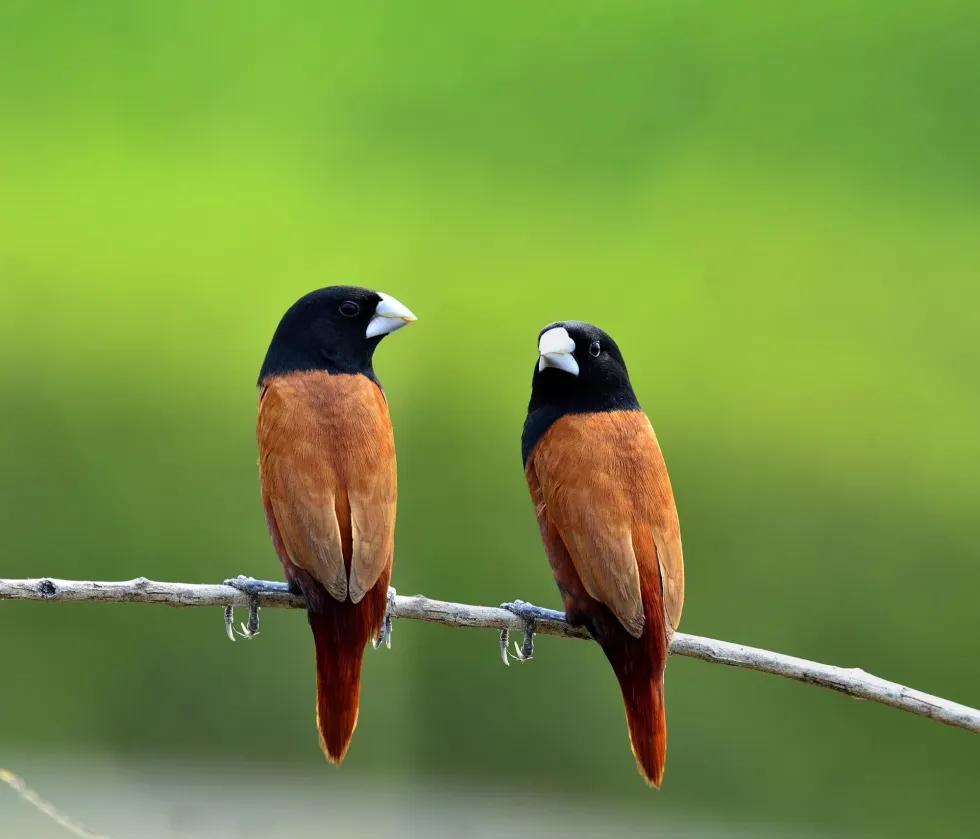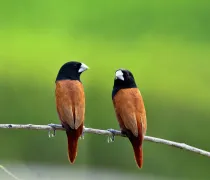The chestnut munia (Lonchura atricapilla), also called the black-headed nun, southern black-headed munia and black-headed munia, is a small bird of the Estrildidae family. This munia bird is mostly chestnut with a black head.
They were previously recognized as conspecific and close relatives of Tricolor munia, but now they are widely accepted as a separate species. The birds in this family are called estrildid finches.
Chestnut munias were the national bird of the Philippines before 1995. In the Philippines, they are called mayang pula which translates to 'red maya', referring to their brick red patch on their lower back visible only in flight.
This red patch is also a distinguishing feature from other birds in urban areas. There are over 10 recognized subspecies of this bird like Lonchura atricapilla sinensis, Lonchura atricapilla jagori, formosana, and Lonchura atricapilla batakana. The species of Munia genus, Lonchura, are also called mannikins.
This word is a derivation from Middle Dutch 'mannekijn', meaning, 'little man'. William Henry Sykes, an Engish naturalist, introduced Lonchura in 1832.
Lonchura has two Greek elements, 'lonkhe', meaning 'spear-head' and 'oura', meaning 'tail'. The genus consists of 27 species.
If these facts about the chestnut munia are interesting, then you must check out more facts about the yellow warbler and yellow-billed cuckoo on Kidadl.
Chestnut Munia Interesting Facts
What type of animal is a chestnut munia?
The chestnut munia (Lonchura atricapilla) is a small munia bird and estrildid finch of the order Passeriformes and phylum Chordata. The chestnut munia is a strong flying bird. This bird is a gregarious species and was previously the national bird of the Philippines. The chestnut munia prefers to feed on the ground and feeds mainly on grains and seeds.
What class of animal does a chestnut munia belong to?
The chestnut munia (Lonchura atricapilla) belongs to the class of Aves of animals.
How many chestnut munias are there in the world?
The exact population number of chestnut munia (Lonchura atricapilla) birds in the world is not known.
Where does a chestnut munia live?
The chestnut munia (Lonchura atricapilla) habitat range extends to regions in Brunei, Bangladesh, India, China, Cambodia, Vietnam, Thailand, Laos, Indonesia, Burma, Malaysia, Nepal, Taiwan, Singapore, Hawai, and the Philippines, Martinique, and the Greater Antilles of Caribbean.
The nominate species, Lonchura atricapilla atricapilla, are found in northeastern India through northwestern Yunnan and Myanmar, and southeastern Nepal.
The Lonchura atricapilla batakana subspecies are found in the mountains of North Sumatra. The Lonchura atricapilla obscura and Lonchura atricapilla selimbauensis subspecies are found in Borneo.
The Lonchura atricapilla rubronigra subspecies are found in the lowlands of Nepal and northern India. The Lonchura atricapilla sinensis subspecies are found in Malaysia, Thailand, and Sumatra. The Lonchura atricapilla jagori subspecies are found in Borneo, Philipines, Sulu Islands, Butung, Sulawesi, Palawan, and Muna.
The Lonchura atricapilla formosana subspecies are found in northern Philippines and Taiwan. Lonchura atricapilla brunneiceps subspecies are found in South Sulawesi and the Lonchura atricapilla deignani subspecies range extends from southwest China to Laos, Vietnam, and Thailand.
What is a chestnut munia's habitat?
The range of the chestnut munia habitat extends to regions with open grasslands, cultivating, and tall grassy areas.
Who do chestnut munias live with?
The black-headed munia (Lonchura atricapilla) lives in folks or pairs.
How long does a chestnut munia live?
The chestnut munia lifespan is not yet known. However, their relatives, scaly-breasted munias (Lonchura punctulata), live for six to eight years.
How do they reproduce?
Only the male southern black-headed munia (Lonchura atricapilla) sings during the breeding season. Their nest is a huge grass structure located in tall grass or bush. In their Indian range, the breeding season is from May to November, in Myanmar breeding takes place from June to September, and in Malaysia, it is from December to October.
The breeding areas are close to water. Breeding can also occur successfully in captivity.
They can be bred at an age of one to four years. One month before breeding, the breeding diet must begin with egg food, sprouted seeds, and live food. It is recommended to keep a group of these birds together so that these birds can choose their mates.
Once the courtship ends, nests are built 3.2-6.5 ft (1-2 m) above ground. Females lay around four to seven eggs. The chestnut munia egg is white-colored. The eggs hatch after an incubation period of 12-15 days and fledge the nest around 22-28 days.
What is their conservation status?
The conservation status of the chestnut munia (Lonchura atricapilla) is evaluated as Least Concern.
Chestnut Munia Fun Facts
What do chestnut munias look like?
The southern black-headed munia is a small bird species with no difference in appearance between sexes but the subspecies differ. Adults have brown plumage with a black head. Some subspecies have black bellies.
Their stubby beak is pale gray. Immature birds have a pale brown top without a black head and with a pale buff belly. These young birds are indistinguishable from young scaly-breasted munias (Lonchura punctulata) and white-headed nuns (Lonchura maja).
The Lonchura atricapilla atricapilla species of India have black under tail coverts, head, and belly. While these species of Myanmar have yellow to yellow-orange upper tail coverts, dark brown belly, and yellowish edged tail.
The Lonchura atricapilla batakana species have black under tail coverts, head, and belly. The upper tail coverts match the rump which is maroon or brown. The Lonchura atricapilla obscura species have a dark brown body. The upper tail coverts match the rump, which is maroon or brown.
The Lonchura atricapilla selimbauensis species have black under tail coverts, head, and belly. The upper tail coverts have slight orange edges and the color matches the rump.
The Lonchura atricapilla rubronigra species are mostly black with maroon or brown rump.
The Lonchura atricapilla formosana species of Taiwan have a dark brown head and gray nape with black belly and undertail coverts, and yellow-orange tail edges and upper tail coverts. The Lonchura atricapilla brunneiceps species have paler nape, dusky to dark brown belly, under tail coverts, and maroon rump with orange tail edges.

How cute are they?
This bird species has a black round head and is considered cute.
How do they communicate?
The black-headed munia species communicate using vocals and body language. Only the males vocalize and their call sounds like a cat's 'meow'.
How big is a chestnut munia?
The black-headed munia measures around 4.3-4.7 in (11-12 cm). These birds are almost half the size of eastern kingbirds.
How fast can a chestnut munia fly?
Black-headed munia birds are strong-flying species. However, their flight speed is not known.
How much does a chestnut munia weigh?
The black headed munia weighs around 0.019 lb (9 g). Mockingbirds weigh almost 10 times more than these birds.
What are the male and female names of the species?
There is no specific name given to female and male black-headed munias.
What would you call a baby chestnut munia?
There is no specific name given to a chestnut munia baby.
What do they eat?
The chestnut munia diet is a herbivorous. This munia feeds mainly on grains and seeds. Although, in captivity, you can feed sprouted seeds, grain mullets, and greens.
Are they dangerous?
No, these munias are not dangerous to human beings.
Would they make a good pet?
Yes, they can make a good pet.
Did you know...
Predators of munias are not known. However, some common predators of small birds are snakes, falcons, eagles, and other birds of prey.
What are the different types of munias?
There are 27 species of munia birds. Some of them are scaly-breasted munias (Lonchura punctulata) of India are named based on their scale-like feather markings on the belly and breast.
The white-headed munia (Lonchura maja) is given this name because of its white-colored head and is quite similar in coloration to chestnut munias. Tricolored munias (Lonchura Malacca) have black heads, chestnut back, and buff underparts. Black-faced munias (Lonchura molucca) are named for their black face and they also have upper breasts, wings, tails, and throats.
How did the chestnut munia get its name?
Chestnut munias are named due to thee chestnut-colored belly, wings, and back. They also have a black head which gives them the name, black-headed munias.
Here at Kidadl, we have carefully created lots of interesting family-friendly animal facts for everyone to discover! For more relatable content, check out these ostrich facts and cliff swallow facts for kids.
You can even occupy yourself at home by coloring on one of our free printable chestnut sided warbler coloring pages.









